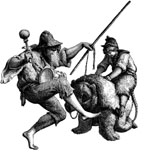
The Hedonistic Death Drive of “Queerness”
ON CONSERVATIVES’ EMBRACE OF SAME-SEX MARRIAGE
The second election of Donald Trump to the presidency is a propitious moment to evaluate the state of conservatism in the United States. Trump was carried back into office in significant measure by a broad reaction against the perceived extremism of woke cultural politics, especially on matters related to gender and sexuality. It is, perhaps, an appropriate time to ask just how well conservatives understand the threat of the cultural Left’s attack on the traditional understanding of human sexuality.
A significant number of conservative public figures who claim opposition to the woke agenda on sexual matters give evidence of being blinded to the full danger of that radical movement. Republican Congresswoman Nancy Mace, for example, is highly critical of the transgender movement, but she has made it clear that she strongly supports same-sex marriage. The writer Batya Ungar-Sargon has expressed this view as a general principle, arguing that Trump-voting conservatives distinguish what they see as the dangers of the radical sexuality movement (the “nihilistic pro-transitioning-children elite”) from the moral conservatism of a “pro-marriage, whatever your orientation side.” In this vision, the construction of a pro-homosexual Left and an anti-homosexual Right is completely distorted — or “nonsense,” as Ungar-Sargon puts it.
It has been argued instead that even the Christian portion of the American Right is fundamentally supportive of same-sex marriage and other elements of a purportedly moderate-conservative effort to recognize homosexuality as a legitimate structure for long-term relationships and social institutions.
Evidence shows that the view of same-sex marriage championed by Mace and Ungar-Sargon is much more common in conservative circles than it was only a decade ago. Recent Pew survey data reveal that nearly half of all Republicans agree that same-sex marriage is a good thing for society. There is variation within the ranks, of course. Only a third of self-described conservative (as opposed to moderate) Republicans agree, though perhaps “only” is the wrong term — it is, after all, a full one in three. Among young (age 18-29) Republicans, the situation is predictably and significantly more affirmative on same-sex marriage: nearly two-thirds of them see it as a good thing.
You May Also Enjoy
Achebe centers on the clash of civilizations between his native Ibo culture and Christian missionaries who established colonial government in Nigeria.
Public schools are thumbing their nose at parents, saying: "We can teach your kids whatever we please, and there's nothing anybody can do about it."
Discipline the seminarian who sways when he walks, who has limp wrists, who acts like a drama queen or who lisps.

